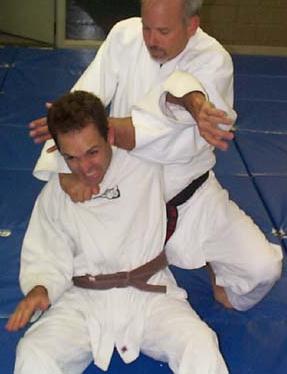by Leonard I. Lapinsohm M.D.
This article was originally published in Black Belt Magazine (1970)
 Strangling techniques are an integral part of judo and jujitsu training. Other martial arts also train their students in the application of various types of strangles. The objective of shime-waza (strangling techniques) is to render the opponent unconscious or when used in sport judo, to render the opponent helpless. Pressure is applied to the neck to reduce circulation to the brain and also to cut off normal breathing. Interfering with brain circulation brings effects within a few seconds and is painless. Interfering with respiration is painful and brings effects in several minutes. In the neck below the angle of the jaw, the common carotid artery splits into two branches. At this point lies the carotid sinus. This is a pressure receptor which takes part in the control of blood pressure and pulse rate. When blood pressure rises in the carotid sinus, reflexes lower both systemic blood pressure and pulse rate. When blood pressure falls in the carotid sinus systemic blood pressure and pulse rate rise. Strangles place direct pressure on both the carotid and vertebral arteries. The former lies in the sides of the neck, the latter enter the base of the brain and are influenced by external pressure in an indirect way. Lowered brain circulation is effected directly by ligature effect when a strangle is applied and pressure gradually increased. If external pressure is applied, thus decreasing pressure in the sinus and suddenly released, the surge of pressure will cause reflex changes resulting in a marked systemic blood pressure drop, faintness, weakness, or unconscious and lowered pulse rate or even heart arrest. Sensitivity of the carotid sinus is present with no known cause and secondary to certain medical conditions. This sensitivity is manifested by sudden faints when pressure is inadvertently applied to the neck as with a tight collar or suddenly turning the neck. Blows to the side of the neck and shime-waza can be extremely dangerous. Therefore, precautionary measures should be taken to insure proper care in application and supervision in teaching. Shutting off respiration may also bring about changes of a reflex nature which may cause serious heart and respiratory reactions. Shutting off the air intake may cause an inadvertent Valsalva maneuver (forced expiration with the glottis closed), which will set in motion other reflex changes and cardiovascular effects resulting in dangerous and even irreversible physiologic changes. If by some mischance, the application of shime-waza results in unconsciousness which does not revert spontaneously, or even cardiac arrest, the use of mouth to mouth resuscitation and closed cardiac massage is indicated. If the sensei is fairly competent in the application of katsu, he may apply the indicated maneuver along with the preceding, until adequate medical help can be secured. It is to be stressed shime-waza should only be applied with proper care and with an understanding of the basic physiological principles, dangers and precautions. |
